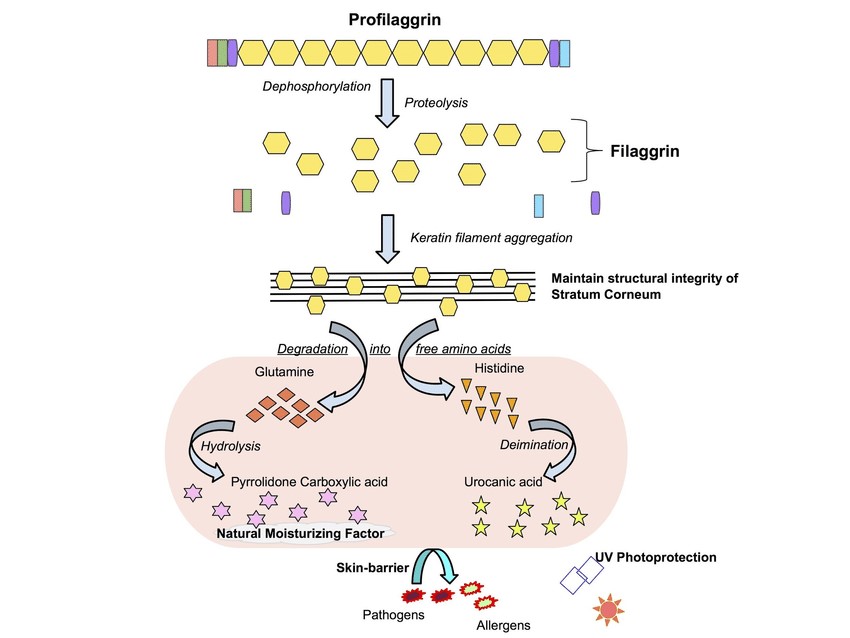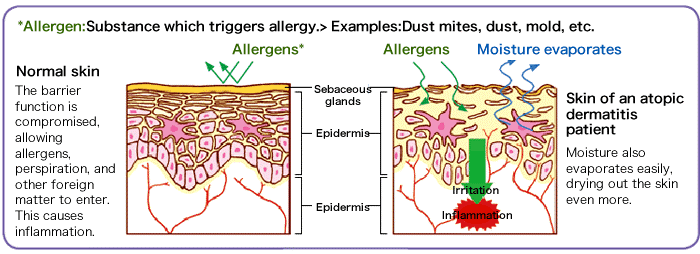
The epidermis protects the human body from exogenous stressors and helps to maintain internal fluid and electrolyte homeostasis.
Atopic dermatitis (AD) is a chronic cutaneous inflammatory disorder, characterized by intense itching, dry skin, and periodic flares of eczema. A disrupted skin barrier allows entry of allergens and lead to systemic allergic responses, such as increased IgE. Skin in patients with AD always presents microscopic injuries even in remission. These micro-cracks allow the entry of pathogens, allergens, and irritants that contribute to inflammation and infection.
Usually AD is observed in a characteristic age-dependent distribution with facial, scalp, and extensor involvement in infants and young children, and predominant flexural involvement in older children and adults. The impact of this disease produces a reduced quality of life (a lack of sleep, social rejection, and psychological problems).
The prevalence of AD is estimated to be 15-20% in children and 1-3% in adults, and the incidence has increased two to three times over the past decades in industrialized countries. AD usually appears between 3 and 6 months of age so that 60% of the cases appear in the first year and around 85% are diagnosed before the age of five. Most children who suffer from atopic dermatitis do not present symptoms in adulthood, but it is estimated that between 10% and 30% of patients will continue to suffer from it during adult life.
A significant epidermal protein,filaggrin, has received much interest for its role in AD.
Filaggrin is important for the formation of the corneocyte, and the generation of its intracellular metabolites contribute to stratum corneum (SC) hydration and pH while also interdicting photons of UV-B irradiation.

Loss-of-function mutations in 1 or both alleles of FLG gene result in reduced (heterozygous) or completely absent levels (homozygous) of epidermal filaggrin and its degradation products. Approximately 10% of Northern European subjects from the general population are heterozygous mutation carriers, and approximately 0.1% is homozygous. The prevalence of FLG mutations in Chinese, Japanese, and Korean subjects reaches 3% to 6%.
FLG mutations cause ichthyosis vulgaris (IV) and constitute the strongest known risk factor for atopic dermatitis (AD). Heritability of this disease is high at 35-95%. So environmental exposures (low humidity, sunburn, skin irritants, psychological stress, age, and water), cytokines (IL-4, IL-13, IL-17, IL-22, IL-25, IL-31, TNFα), microorganisms (Human papilloma virus, Tinea corporis) and topical therapy (dithranol, retinoic acid) can reduce levels of epidermal filaggrin.

In a study by Saif et al. (2018) the serum levels of filaggrin in 1,246 patients with different atopic disorders (bronchial asthma, allergic rhinitisand atopic dermatitis ) and their levels were compared with 410 healthy human controls. The data showed a significantly higher serum filaggrin levels in patients with different atopic disorders compared with healthy controls. Patients with bronchial asthma and allergic rhinitis had almost similar levels of filaggrin as patients with atopic dermatitis.
These data suggest that filaggrin might be useful in elucidating the mechanism involved in the pathogenesis of these disorders.
The results of trials and long clinical experience have proven that emollients are safe and effective in patients with atopic dermatitis. Dermacare is a new cosmetic formulation, which enhances moisturization, reinforces and repairs the skin barrier, and prevents cutaneous microbiota imbalance. Eight-week clinical studies were conducted to assess the efficacy and safety of this new cosmetic product for the treatment of children diagnosed with mild to moderate atopic dermatitis during remission.
This study was carried out to two different pediatric dermatology departments at the La Pay University Hospital (Madrid) and University Clinic of Navarra (Spain). A total of 19 subjects were recruited.
The new cosmetic formulation (Cantabria Labs, lotion formulated with highly emollient system that enhances skin hydration, as well as the strengthening and repairing the skin barrier, this emollient includes pro-filaggrin complex, urea, xylitol) was applied to patients twice for 28 days. After 14 days, were reduced 36.7% eczema and at the end of the 28-day treatment showed a reduction of eczema in 70% of patients with atopic dermatitis.
A regular use of this new formulation can reduce the risk of relapse and extend the steroid-free treatment periods.
Sources: Children,DOI: 10.3390/children6020017
Intractable Rare Dis Res.,DOI: 10.5582/irdr.2018.01111
